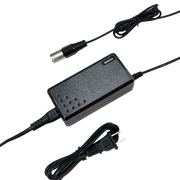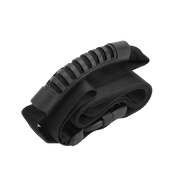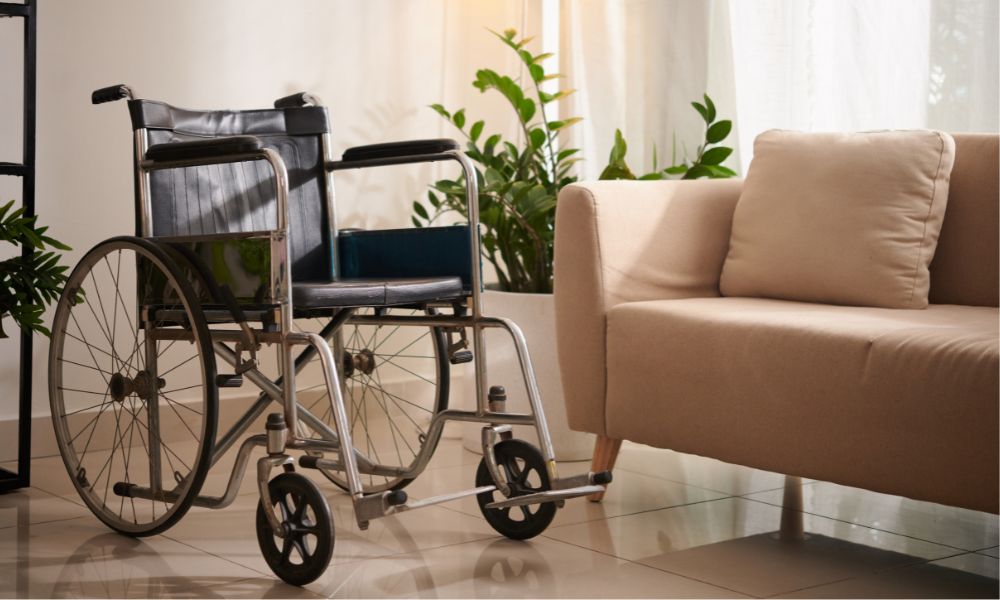Over time, you discover that the brakes on your older black wheelchair are not functioning properly, with brake lines or components coming loose, making it harder to keep the wheelchair stationary when needed. Adjusting the brakes on an older wheelchair is a simple process that can be done with just a few simple tools.
In this guide, we'll take a look at the types of brakes on older wheelchairs and why they may break. We will walk you through the steps to help restore your wheelchair's braking power, ensuring your safety and comfort.
What Type of Brakes Are Found on Older-Style Wheelchairs?
Older wheelchairs have simpler brake systems than modern power wheelchairs, prioritizing ease of use and durability. Here are the most common types of brakes found on wheelchairs:
- Push-to-Lock Brakes: These brakes are usually mounted on the rear wheels, and you simply push the brake lever into a fixed position to lock the wheelchair in place. They are simple to use and are great for ensuring your wheelchair remains stable when you need to park it.
- Pull-to-Lock Brakes: Unlike push-to-lock brakes, pull-to-lock brakes require you to pull the brake lever to lock the wheelchair. This type is common in older models and is great if you need extra stability or force to engage the brakes, providing a more secure grip.
- Ring Brakes: Ring brakes are usually mounted on the outer rim of the rear wheels, and you pull the brake ring to slow or stop the wheelchair. While this is a basic design, it is very simple and effective and is often found in older wheelchairs due to its simplicity and reliability.
- Foot Brakes: Foot brakes allow you to control the brakes with your feet, and they are ideal if you have limited hand mobility. These brakes are usually located on the side of the wheelchair or on the footrest, and you can easily press or release them to keep your wheelchair stable.
- Cam and Lever Brakes: This system uses a lever to adjust the tightness of the brakes, giving you precise control over how tight or loose the brakes are. It usually requires manual adjustment and is great if you want more precision or need to adjust brake tension regularly.

What Are the Common Causes of Brakes Not Working on a Wheelchair?
Loose or Broken Brake Cables
Over time, brake cables can become loose or broken due to wear and tear or age. When the brake cables lose tension, they are unable to engage the brakes effectively, causing the wheelchair to not stop properly.
Worn Brake Components
The friction material of the brakes, such as the brake pads, can wear or deteriorate from prolonged use. This can reduce the effectiveness of the brakes, making them unable to provide enough friction to fully stop the wheelchair. For electric wheelchairs, worn brake pads can be even more problematic, as they impact both manual and power functions.
Loose Brake Lever or Adjustment Screw
If the brake lever or adjustment screw is loose, it can affect the proper adjustment of the brakes. Loose components can prevent the brakes from tightening, making them unable to effectively stop the wheelchair.
Dirt or Rust in the Brake System
Dirt, dust, or rust in the brake system can impede its function. Especially around the brake cables or brake rings, accumulated dirt and rust can make the brakes sluggish or prevent them from fully locking the wheels.
Brake Lever Design Issues
Some older wheelchairs may have poorly designed brake levers that are not ergonomically positioned. If the brake levers are hard to reach or incorrectly positioned, you may have difficulty applying enough force to fully engage the brakes.
Misaligned Brake Components
Misalignment of brake components Frequent use or impact can cause misalignment of brake components. This misalignment prevents the brakes from properly engaging the wheels, affecting their ability to stop the wheelchair and requiring realignment.
What Tool Should Be Used to Loosen or Tighten Brake Lines?
To loosen or tighten the brake cables for both manual and electric wheelchair types, you'll usually need a wrench or adjustable spanner. The exact size will depend on the wheelchair's brake system, but most commonly a 10mm or 12mm spanner will be needed.
If you are adjusting the brake cables themselves, you may also need a hex key (Allen key) to fine-tune the tension. It is important to use the correct size tool to avoid damaging any parts. When making adjustments, apply pressure gradually and check the brakes frequently to ensure they are working properly.
How Do I Tighten the Brakes on a Wheelchair?
Find the Brake Adjustment Mechanism
First, find the brake adjustment mechanism, which is usually located near the rear wheel of the wheelchair. It may be a small screw or lever that connects to the brake system. It is usually close to where the brake connects to the wheelchair frame and is easy to find. However, in some cases, you may need to remove a cover to access the adjustment parts.
Check the Brake Cable Tension
Check that the brake cable is not too loose. A loose cable will prevent the brakes from fully engaging, making it difficult for the wheelchair to stay still. You can use a wrench or hex key to adjust and tighten the brake cables, making sure they are tight enough for the brakes to work properly. Also, tightening the cables allows the brake pads to make firm contact with the wheel when you apply the brakes.
Adjust the Brake Lever or Handle
If your wheelchair uses a brake lever or handle, check to make sure it is securely fastened. You can use a wrench or adjustable wrench to tighten any loose screws or bolts that connect the lever to the frame. A secure brake lever ensures that you can engage the brakes with enough force. Also, check that the position of the lever is comfortable so that it can be easily applied when needed.
Test the Brakes
After making adjustments, test the brakes by engaging the lever or brake mechanism. The wheelchair should stay still when the brakes are applied. If the wheelchair continues to roll, the brakes may still need to be tightened further. Always make sure the brakes are fully functional and keep the wheelchair stable when engaged.
Make Fine Adjustments as Needed
If the brakes feel too loose or too tight, make small adjustments until the proper tension is achieved. Be careful not to over-tighten, as this can cause undue stress on the components or make it more difficult to release the brakes. After adjustments, test the brakes again to ensure they are operating correctly and safely.

How Do I Safely Maintain and Inspect My Wheelchair Brakes?
Here's how you can easily care for and inspect your wheelchair brakes at home:
Daily Maintenance Tips
- Clean the Brake Area: Use a clean, dry cloth to wipe away dust and debris around the wheels and brake pads. This prevents buildup that could affect braking.
- Check the Rubber Brake Tips: If the rubber tips are worn out or no longer grip the tire properly, it's time to adjust or replace them.
- Lubricate Moving Parts: Apply a small amount of lubricant (such as WD-40) to brake joints or pivot points to ensure smoother function. Avoid getting lubricant on the tires or brake pads themselves.
Safety Precautions During Maintenance
- Work on a Flat Surface: Always perform brake maintenance on a level, stable surface. Never attempt adjustments on a slope.
- Do Not Sit in the Chair While Adjusting: Make sure no one is in the wheelchair while you're adjusting the brakes to prevent accidental movement.
- Wear Gloves: Protect your hands from potential pinches, sharp edges, or dirt.
What Are the Common Types of Modern Electric Wheelchairs?
If the brakes on your old wheelchair are not working or are too much trouble to repair, then it may be time to upgrade. Modern electric wheelchairs can make your daily travel easier. Here are the common popular electric wheelchair types:
- Lightweight Electric Wheelchair: If you travel frequently, a lightweight electric wheelchair is perfect for traveling with you. It is easy to fold and lightweight, and can be put directly into the trunk of the car.
- Compact Electric Wheelchair: This compact wheelchair is designed for smaller spaces. They are easy to maneuver and suitable for use in the kitchen, bathroom, or coffee shop with high traffic.
- Carbon Fiber Wheelchair: Carbon fiber wheelchairs are sturdy and lightweight, suitable for those who travel frequently or just like simple and durable wheelchairs.
FAQs
How to tighten the brakes on a manual wheelchair?
Tightening the brakes on a manual wheelchair is easy, usually located near the rear wheel or brake lever. You can use a wrench or Allen key to tighten it until there is enough tension in the brake line. Also, use a brake test to make sure the wheelchair stays still. If the problem persists, check the brake pads for wear or other problems.
How often should I check and adjust my wheelchair brakes?
It’s important to check your wheelchair brakes regularly, ideally at least once a month. During each check, make sure the brakes engage properly and aren’t too loose or tight. If you use your wheelchair daily or in environments with heavy use, you may need to inspect the brakes more frequently. Regular maintenance helps prevent issues and ensures your safety while using the wheelchair.
What if my wheelchair brakes are still not working after tightening?
If the brakes still aren’t working after tightening, the issue could be with worn-out brake pads, a broken brake cable, or a malfunctioning brake system. In such cases, the brake pads may need replacing, or the cables might need rethreading or replacing entirely. It’s advisable to take your wheelchair to a professional technician for a thorough inspection and repair if tightening doesn’t resolve the problem.
Related Reading:
Wheelchair Wheels Are Peeling What Do I Do?
Can You Get a Mobility Scooter on Disability?
How Do Tighten the Brakes on an Older-Style Black Wheelchair?























Leave a comment
This site is protected by hCaptcha and the hCaptcha Privacy Policy and Terms of Service apply.